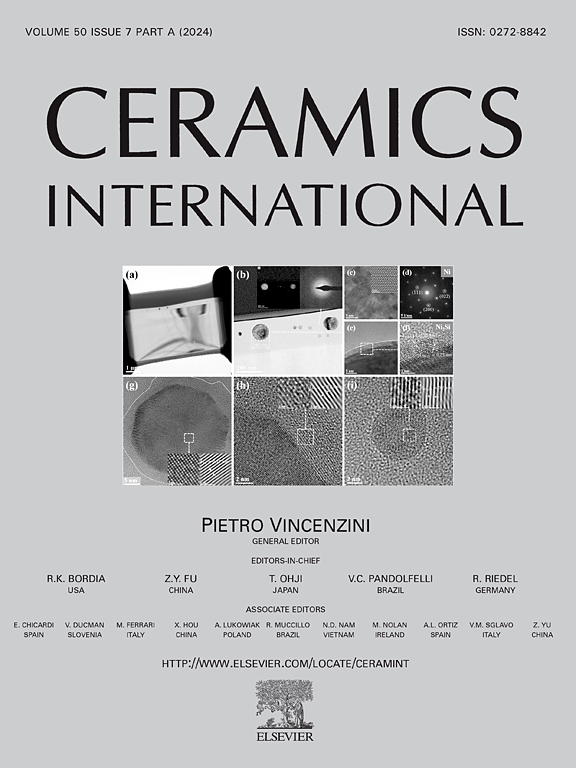无偏析钙钛矿氧化物通过热松弛-冲击策略实现活性和持久的氧催化
IF 5.6
2区 材料科学
Q1 MATERIALS SCIENCE, CERAMICS
引用次数: 0
摘要
惰性分离一直是限制钙钛矿氧化物作为氧催化剂在固体氧化物燃料电池(sofc)、固体氧化物电解电池、化学传感器和高温氧分离膜中的应用的挑战。在此,我们提出了一种热松弛-冲击策略,使无偏析的钙钛矿氧化物成为可能。对于热松弛过程,La0.6Sr0.4Co0.2Fe0.8O3-δ (LSCF)在高温下进行长时间热处理。在此阶段,随着偏析层的增长,LSCF中晶格应变和化学缺陷之间的静电相互作用得到有效放松,偏析金属离子向表面的扩散速率趋近于零。在随后的热冲击过程中,将松弛的LSCF在液氮中淬火,在不破坏其显微组织的情况下去除偏析层。经热松弛-冲击处理的LSCF表现出高的氧催化活性,在SOFC体系中长时间稳定运行,并且没有明显的表面偏析层。这一发现为先进催化剂的设计和开发提供了一条新的途径。本文章由计算机程序翻译,如有差异,请以英文原文为准。
Segregation-free perovskite oxides enabled by a thermal relaxing-shocking strategy for active and durable oxygen catalysis
Inert segregations are persistent challenges limiting the application of perovskite oxides as oxygen catalysts in solid oxide fuel cells (SOFCs), solid oxide electrolysis cells, chemical sensors, and high-temperature oxygen separation membranes. Herein, we present a thermal relaxing-shocking strategy that makes segregation-free perovskite oxides feasible. For the thermal relaxing process, La0.6Sr0.4Co0.2Fe0.8O3-δ (LSCF) is subjected to prolonged heat treatment at high temperatures. As the segregation layer grows during this phase, the lattice strain and electrostatic interactions between chemical defects in LSCF are effectively relaxed, and the diffusion rate of segregated metal ions to the surface approaches zero. In the subsequent thermal shocking process, the relaxed LSCF is quenched in liquid nitrogen, which removes the segregation layer without damaging its microstructure. The LSCF treated with the thermal relaxing-shocking process exhibits high oxygen catalytic activity, operates stably in SOFC systems over extended periods, and shows no observable surface segregation layer. This finding offers a new avenue for the design and development of advanced catalysts.
求助全文
通过发布文献求助,成功后即可免费获取论文全文。
去求助
来源期刊

Ceramics International
工程技术-材料科学:硅酸盐
CiteScore
9.40
自引率
15.40%
发文量
4558
审稿时长
25 days
期刊介绍:
Ceramics International covers the science of advanced ceramic materials. The journal encourages contributions that demonstrate how an understanding of the basic chemical and physical phenomena may direct materials design and stimulate ideas for new or improved processing techniques, in order to obtain materials with desired structural features and properties.
Ceramics International covers oxide and non-oxide ceramics, functional glasses, glass ceramics, amorphous inorganic non-metallic materials (and their combinations with metal and organic materials), in the form of particulates, dense or porous bodies, thin/thick films and laminated, graded and composite structures. Process related topics such as ceramic-ceramic joints or joining ceramics with dissimilar materials, as well as surface finishing and conditioning are also covered. Besides traditional processing techniques, manufacturing routes of interest include innovative procedures benefiting from externally applied stresses, electromagnetic fields and energetic beams, as well as top-down and self-assembly nanotechnology approaches. In addition, the journal welcomes submissions on bio-inspired and bio-enabled materials designs, experimentally validated multi scale modelling and simulation for materials design, and the use of the most advanced chemical and physical characterization techniques of structure, properties and behaviour.
Technologically relevant low-dimensional systems are a particular focus of Ceramics International. These include 0, 1 and 2-D nanomaterials (also covering CNTs, graphene and related materials, and diamond-like carbons), their nanocomposites, as well as nano-hybrids and hierarchical multifunctional nanostructures that might integrate molecular, biological and electronic components.
 求助内容:
求助内容: 应助结果提醒方式:
应助结果提醒方式:


